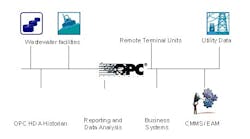By Eric Murphy, Columnist
The old idiom about wise use of your resources is particularly true when talking about Waster water management. The two key business initiatives wastewater facilities strive for is improved efficiency and meeting regulatory compliance. Both these ends can be achieved through improved on-line monitoring with OPC.
Can’t Afford to Waste Time or Energy
Throughout the world municipal wastewater treatment facilities are faced in increased demands on the services they provide. Many wastewater infrastructures have legacy systems in need of upgrading and adequate future expansion. Many include multiple plant sites spread out over a wide geographic area, with each site including a mixture of networks and processes that are not adequately connected. The challenge every water and wastewater utility executive faces is how to run these extensive day-to-day operations as an efficient business, while managing supply operations, customer service and complying with government regulations. Any business, efficient or otherwise is not in business long if they don’t operate in compliance with federal and state regulations. This means taking a number of critical readings throughout the day as well as the preparation of formal reports.
The reliability of aging infrastructure and increased demand on strained systems is a worry from both an efficiency and regulatory point of view. All elements of water and wastewater entities require reliable monitoring, such as the phases of product delivery including wells, pumps, tanks and purification facilities. Wastewater organizations need to monitor lift stations, treatment plants and storage facilities. Critical drainage systems of canals and the huge pumping facilities require monitoring for the storm water performance particularly during heavy storms. In order to ensure these systems are working as they should receiving real-time information and utilizing reliable communications is crucial.
OPC Lays Waste to the Problem
OPC can provide real time data access for remote supervision, control, and data acquisition required for operation and maintenance. It also is a means of standardized communication among energy management centers and regulatory bodies. High resolution data is essential for optimizing wind farm assets and realizing incremental gains critical to improving the bottom line. OPC not only overcomes the challenges of gathering data from various sources into a centralized repository, but also ensuring guaranteed deliver of the data, even if it spans different manufacturers, technological generations or geographical locations.
The OPC specification ensures that regardless of the underlying system and the product vendor, the interfaces will connect and exchange data in the same way. Water collection and distribution architectures are composed of geographically disperse assets such as remote terminal units or RTU’s. RTU locations can range from simple applications through complex automation locations that require support of large numbers of data inputs. OPC servers are available for the full range of the industry standard communication protocols such as Modbus, DNP, and IEC870. Telemetry grade OPC servers are also available that handle communication challenges in topologies such as fiber, radio, satellite, or telephone architectures. This includes robust features like redundant communication channel support and configurable polling cycles.
Figure 1 – Standardized OPC Data Collection Architecture
Without adequate monitoring infrastructure maintenance becomes driven by customer complaints. When a customer calls in problem, service people must begin the labor-intensive task of locating the root cause. Using OPC DA to gather real-time information, and OPC based historian solutions to store the information will provide the data needed to proactively identify and correct infrastructure problems before they affect service. Historized data is used for many functions including efficiency improvements, statistical process control, quality assurance and reporting. Storing the real time process data allows wastewater management companies to create genealogical records of processes, track equipment conditions and better forecast and schedule maintenance.
Waste No Time in Getting a Solution
OPC communication ensures wastewater facilities can connect their aging infrastructure or legacy equipment in a standardized fashion. Standardizing access with OPC supplies a better way to manage facilities and control assets by providing applications with real-time data and critical information on each point in the system. As water and waste treatment utilities invest in newer technology like smart meters and intelligent grid operations, OPC will be a key component in creating an interoperable system. OPC standardizes data collection so utilities can better evaluate data, perform procurement functions, reconcile and settle billing and transactional activities. This results in a higher level of service to customers, increased agility, and improves the bottom line. Who would want to waste that opportunity?




